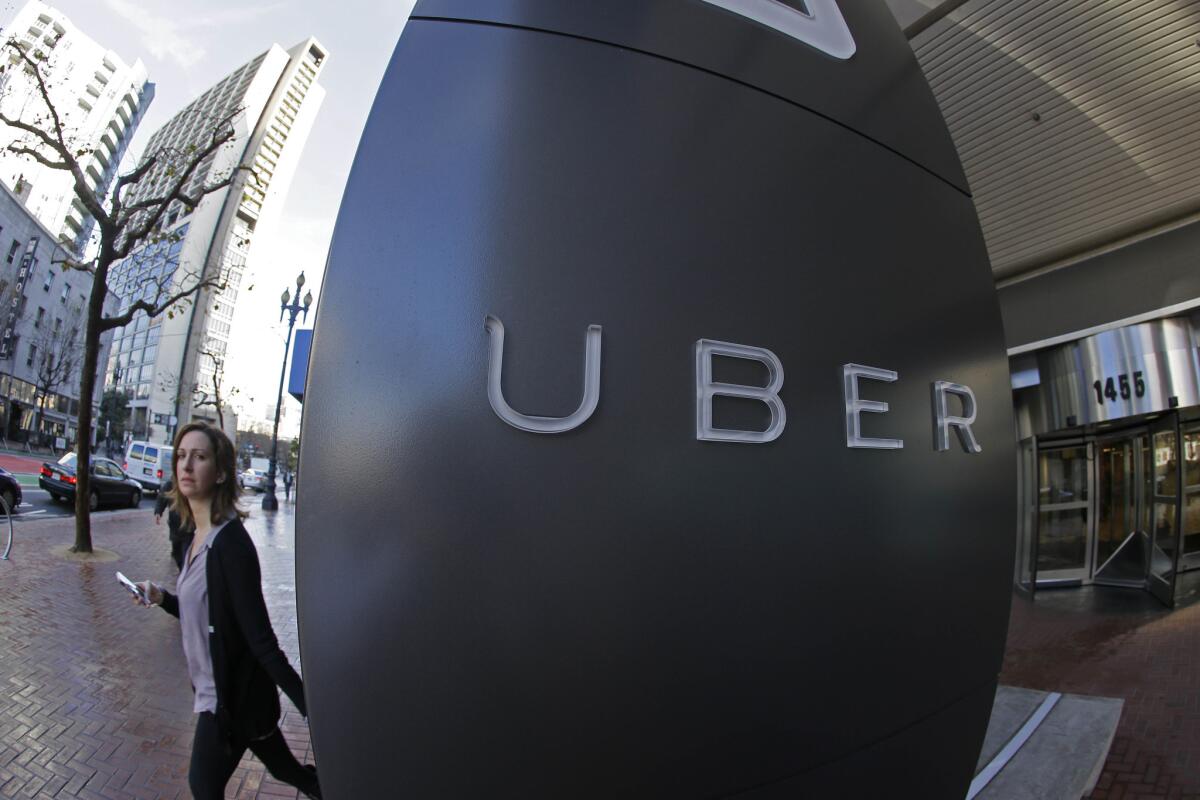Op-Ed: Is your Uber driver an independent contractor or an employee? It makes a difference

A woman leaves the headquarters of Uber in San Francisco last December.
- Share via
Do Uber and Lyft merely provide an app, or a driver? For consumers, ordering car service — or lately, house cleaning, lunch delivery or dry-cleaning pickup — can be as simple as touching an icon on a smartphone. But when the people who actually do the work show up, are they merely independent contractors matched to consumers by a software company, or are they employees?
How we answer that question has consequences in terms of wages, benefits and on-the-job protections against safety hazards, as well as discrimination and harassment. The “sharing economy” is accelerating employers’ drive to classify more and more workers as independent contractors. At hair salons and manicure establishments, at janitorial services and home care agencies, this old trick is posing real risks to our system of labor and employment laws.
In the sharing economy, the rules of employee classification are now in the hands of the courts. Uber and Lyft are facing lawsuits in federal court in Northern California that challenge their designation of drivers as contractors — and their practice of offloading the costs of gas, insurance and vehicle upkeep, and of providing no benefits. The companies claim to be only the cyber middleman between drivers and customers, but they also set stringent work rules and can fire drivers; their large workforce may be entitled to be treated as employees.
A decision on the underlying legal issue of who is an employee and who isn’t may set a precedent for the app economy — and for the future of our protective labor laws.
There are a lot of ways to avoid labor laws: working staff beyond 40 hours a week, for example, or shortening schedules (and pay) without warning, simply ignoring overtime or violating health and safety laws in the face of lax enforcement.
But perhaps the most ingenious approach is saying that a company’s workers aren’t actually its workers at all, and thereby shrugging off any responsibility to them, and any liability. By calling certain staff members independent contractors or hiring through temporary agencies or as part-time workers, the boss is suddenly free from many of the financial burdens — but not the benefits — of having employees.
The societal consequences are significant, allowing the circumvention of protections that guarantee workers a decent wage, maternity leave, protections from harassment and discrimination — the kinds of things President Obama has characterized as “basic needs,” not bonuses: “They should be part of our bottom line as a society.”
In addition, giving employers the latitude to use temps and independent contractors has segmented the workforce, even within a single employer, between “real” employees, more often white and professional, who get benefits, and the non-employees, more likely to be female and minority, who get nothing. In a 1995 law review article, Jon Hiatt, a senior official at the Service Employees International Union, now at the AFL-CIO, perceptively described this weakness in our legal system as one that allows companies to “distance themselves from the exploitation of the low-wage workers while benefiting from their exploitation.”
According to the Bureau of Labor Statistics, in 2005, more than 8% of the workforce, or more than 10 million workers, were counted as independent contractors. In 2000, the Department of Labor commissioned a study that estimated that nearly a third of all employers misclassified some employees as contractors; a 2005 study found that more than 10% of workers in the private sector had been wrongly designated as contractors. In 1993, 7% of workers were independent contractors or temps; economists estimate this number will grow to 20% by 2020.
It’s true that there are many independent contractors — financial planners for example, or a wide variety of consultants — who choose to work client by client, who make good wages, set their own schedules, pay for their own health insurance and truly choose to be self-employed. But at least 3 million people, or a third of the more than 10 million considered independent contractors, are employed in low-wage jobs, and they would most likely prefer to be regular employees.
Some industries are infamous for trying to characterize what is essentially their regular workforce as independent contractors, particularly the janitorial, home care and secretarial services, which are dominated by women and immigrant workers. Those workers lose their right to unionize, to minimum wage and overtime; their bosses don’t pay into unemployment or workers’ compensation programs and take no responsibility for safety and health violations on the job.
As far back as 1993, Secretary of Labor Robert Reich and Secretary of Commerce Ronald H. Brown commissioned a study to examine the evolving workplace at the end of the 20th century. It took particular note of the dangers of the fragmentation of legal protections for certain workers: “The growing number of ‘contingent’ and other nonstandard workers poses the problem of how to balance employers’ needs for flexibility with workers’ needs for adequate income protections, job security and the application of public laws that these arrangements often preclude, including labor protection and labor-relations statutes.”
Policymakers did not listen then, but with app-summoned workers and those in the ever-growing service economy facing the erosion of job protections that have been hard won and long practiced, it’s past time to force them to pay attention.
Caroline Fredrickson is president of the American Constitution Society for Law and Policy and the author of “Under The Bus: How Working Women Are Being Run Over.”
Follow the Opinion section on Twitter @latimesopinion and Facebook
More to Read
A cure for the common opinion
Get thought-provoking perspectives with our weekly newsletter.
You may occasionally receive promotional content from the Los Angeles Times.









